Welcome back to Season 13 of the Neuroscience Meets Social and Emotional Learning Podcast. In this episode, join Andrea Samadi as we delve into practical neuroscience applications for self-leadership in 2025. Discover how to balance various aspects of life through insights from Grant "Upbeat" Bosnick's book, 'Tailored Approaches to Self-Leadership.'
We explore strategies from four key chapters, focusing on leveraging neuroscience to level up your goals, the inspiration behind motivation, the benefits of mindfulness, and the art of achieving flow states. Learn actionable steps for overcoming obstacles and using positive forces to drive personal growth.
Whether you're implementing new habits or seeking motivation, this episode serves as a guide to harnessing the full potential of your mind and achieving greater heights.

Welcome back to SEASON 13 of The Neuroscience Meets Social and Emotional Learning Podcast, where we connect the science-based evidence behind social and emotional learning and emotional intelligence training for improved well-being, achievement, productivity and results—using what I saw as the missing link (since we weren’t taught this when we were growing up in school), the application of practical neuroscience. I’m Andrea Samadi, an author, and an educator with a passion for learning and launched this podcast 6 years ago with the goal of bringing ALL the leading experts together (in one place) to help us to APPLY this research in our daily lives.
Now, we are well into 2025, and if you are listening today, I want to congratulate you. Not everyone chooses to do the work that is needed for self-improvement. It’s something I’m dedicated to working on each year, and like you, those who tune in each week, implementing the ideas we write down in our notebooks, and even the ones we highlight in yellow, this is the hardest work in the room. I just want to recognize you for showing up here, and tuning in to grab some ideas, do this difficult work, and take the ideas that you learn from the research, and put them into action.
Like you, I am doing this as well. We interviewed Kristen Holmes, the VP of Performance Science from Whoop.com back in May 2021, on EP134[i] when I had first started using the wearable device to measure my sleep, strain and daily recovery. She told me something I already knew, and that was that my sleep needed work. She said it much sterner than this, but I heard it, loud and clear, especially since my brain scan from Amen Clinics, that we reviewed on EP 84[ii] came back and showed that I was sleep deprived. Changing behaviors, habits and daily routines, and changing the trajectory of our health is all possible, but actually sustaining the change—this is what I’m looking for. This is why I am doing these podcast episodes, and sharing what I’m learning along the way. It took me 4 years to finally improve my sleep, but to do this, I had to sacrifice something else important to me, and that was my early morning workouts. I’m sure if you are listening, you would understand and know exactly what I am saying here. While making improvements with one area of our life, we tend to do this at the expense of another area. I’m determined to prove that we can have it all, and hopefully, at the end of this review, we can all find a way towards improving the balance in the important areas of our lives.
REMEMBER: “Mastering others is strength; mastering oneself is true power” - Lao Tsu
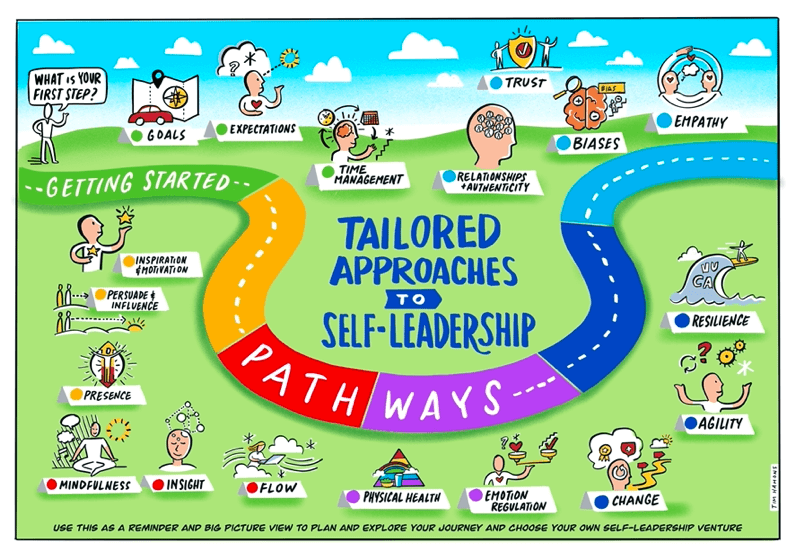
Now wouldn’t it be great to have a tool (like a map) that tells us what is important to focus on each year, based on what we say is important to us in our work or personal lives?
Now sleep is not on the map we are covering today, as we will review the 19 chapters from Grant Bosnick’s book, but I would put sleep right at the top of the list, along with the Top Health Staples that we covered back on a bonus EP we did in 2022[iii] where we first covered the importance of daily exercise, good quality sleep, eating a healthy diet, understanding how to balance our gut-brain axis, how to listen to our hunger cues with intermittent fasting, and the importance of stress reduction (that I think we could cover more in depth this year).
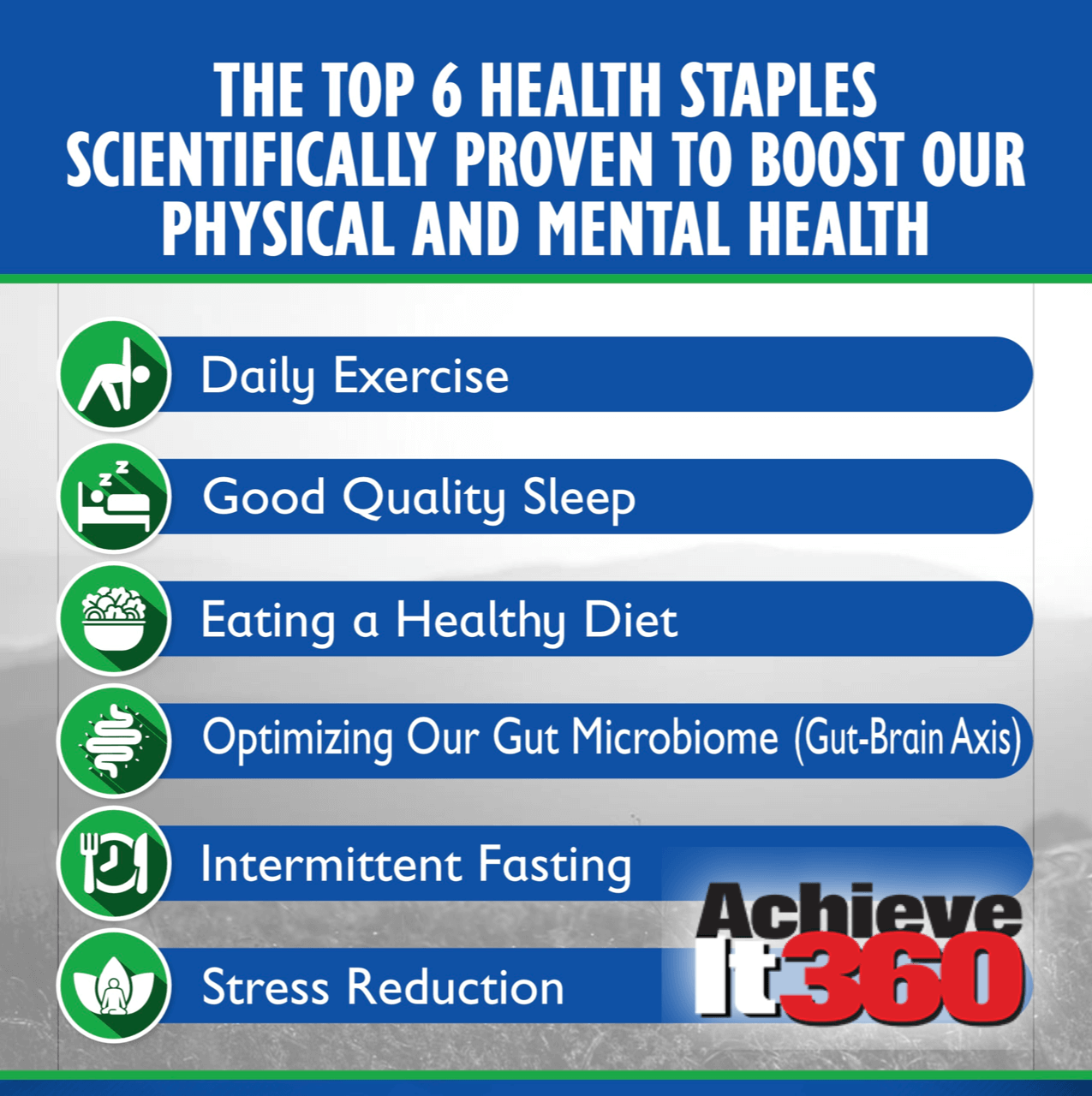
((If you took the leadership self-assessment[iv] last year, go back and take it again, and see if any of the areas have changed for you.))

And now we will begin PART 1 of our 4-PART review, to sum up last year, 2024, and our entire year studying one book, Grant Bosnick’s “Tailored Approaches to Self-Leadership: A Bite Size Approach Using Psychology and Neuroscience” that we first dove into with our interview on EP #321[v] the end of January 2024. The goal was that each week, we focused on learning something new, (from Grant’s book) tied to the most current neuroscience research, that builds off the prior week, to help take us to greater heights this year. It honestly shocked me that this series took the entire year.
Today we will review chapters 2-5 (the first chapter was an introduction to the book).
((On today's EPISODE #355 PART 1 of our review of Grant Bosnick’s Tailored Approaches to Self-Leadership, we will cover)):
✔ EP 323 Chapter 2[vi] “Using Neuroscience to Level Up Your Goals”
✔ EP 324 Chapter 3[vii] “The Neuroscience of Inspiration”
✔ EP 325 Chapter 4[viii] “The Neuroscience of Mindfulness”
✔ EP 326 Chapter 5[ix] “The Neuroscience of Flow”
We will go through each of the 19 chapters, and cover the action steps in this review.
EP 323 Chapter 2[x] “Using Neuroscience to Level Up Your Goals”
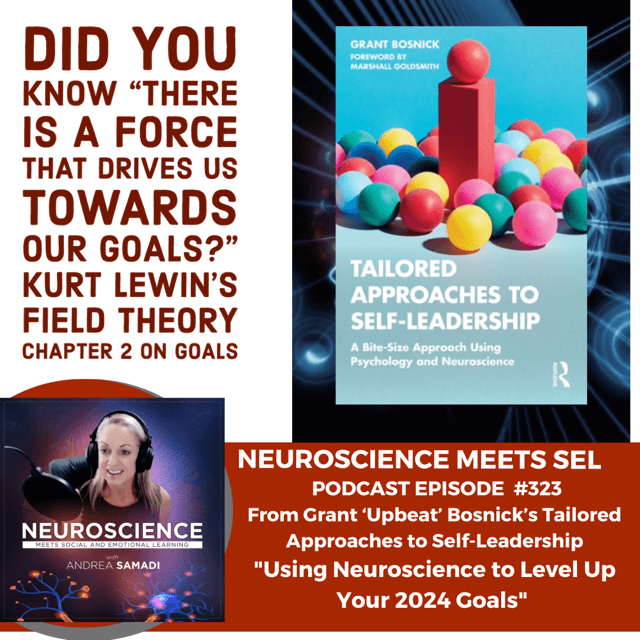
What I loved the most about this chapter on goals, was learning about Kurt Lewin’s Field Theory that says “there is a force that drives us towards our goals.” (Chapter 2 on goals). The idea is that we learn to use this force to push us towards whatever it is that we want.
Here’s a REVIEW of 3 steps to implement Kurt Lewin’s Field Theory to push us towards our goals this year.
STEP 1 RECOGNIZE THE NEGATIVE FORCES THAT PUSH US AWAY FROM OUR GOALS: Know that whenever we are moving towards a goal, there will be a force that pushes us down from our current state of attaining that goal, (a negative force) and there’s also a force that helps us to change (a positive force). Identify the forces that are pushing you down as you move towards your desired end result.
In our schools: it could be limited time to study for a test. (as a negative force).
In our sports environments: it could be our competition, or whoever is at the top of the league.
Finally, in our workplaces: it could be a competitor charging lower pricing, and taking all the business in your area.
STEP 2 RECOGNIZE THE POSITIVE FORCES THAT PUSH US TOWARDS OUR GOALS: Recognize that just as there is a negative force pushing us down, there are also positive forces that pushes us up, and can assist us to change. It’s this force pushing us up that Grant talks about in his chapter on goals. He says that “the closer we get to our target (or perception of being closer to the target) the strength of the force increases.” (Page 20, Grant Bosnick, Tailored Approaches to Leadership).
STEP 3 FIND THE MOMENTUM THAT TAKES YOU TO A NEW LEVEL OF PERFORMANCE:
It’s here in the diagram where I drew a RED arrow, showing a person moving from their current state, leveling up to a new, heightened level of performance, when there are MORE positive forces pushing us up, than negative pushing us down.
BEFORE we can get to our new heightened level of performance, we must overcome the forces against whatever it is we are moving towards, (like by overcoming our competition) and create as many positive forces to help us to move towards our NEW end result.
Revisiting this concept this year, I suggest we all create a plan for how we will overcome our resistances, while building up positive forces for change (like through study, identifying ways to improve our mental and physical health so we can use these forces to push up against the negatives, or from understanding our “why” so this internal force drives us forward when times are difficult.
Another thought here, is to find ways to increase our capacity to handle stress. I recommend listening to EP 228[xi] where we reviewed “HRV (heart rate variability) The Most Important Biomarker for Tracking Health, Recovery and Resilience” as this episode gives examples of how to build more capacity to handle these day to day negative forces, and create healthy ways to push us towards our goals.
REVISIT THIS EPISODE TO REVIEW THIS CONCEPT IN DEPTH
EP 324 Chapter 3[xii] “The Neuroscience of Inspiration”
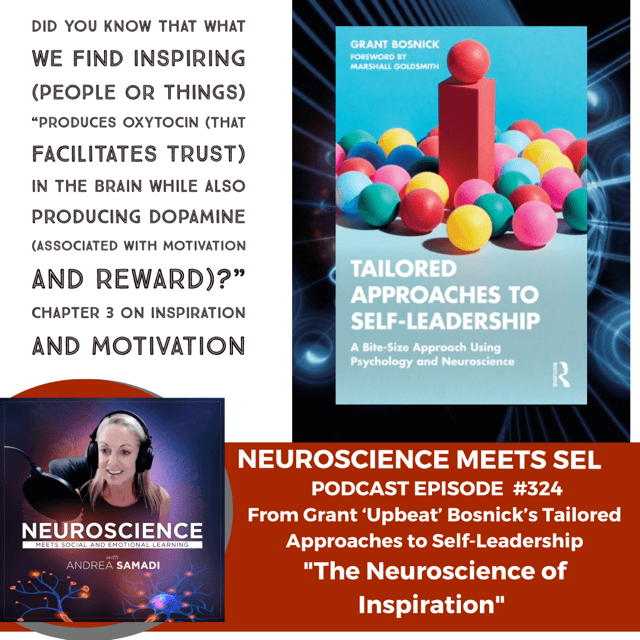
This chapter on inspiration and motivation came up as a high level of importance for me last year, and I’m always looking to deepen my understanding on where I find inspiration from, and why, with the idea that “what we find inspiring (people or things) produces oxytocin (that facilitates trust)in the brain while also producing dopamine the neurotransmitter that’s associated with motivation and reward.” There’s a lot at play when we find what motivates and inspires us day to day.
PUTTING THE NEUROSCIENCE OF INSPIRATION INTO PRACTICE:
- WRITE:
Write a list of:
- Who inspires you, and why?
- Do you feel trust with this person that could be a performance multiplier? Think about this. Why, or why not?
- What inspires you, and why?
- Do you feel motivation from places that we know can rewire our brain and make new neural connections?
- THINK:
Think of your brain being bombarded by oxytocin (the neurochemical that facilitates the feelings of trust) and then dopamine (the neurochemical associated with motivation and reward) and then the NEW neural pathways that are being rewired into your brain with whatever it is that you are drawing inspiration from.
- LEARN:
What does this mean to you? Does it help you to make sense of your world in a new way? Does this connection to science help to motivate you in a NEW way, perhaps pushing you past some of the obstacles that once held you back? Does this NEW understanding energize you in some new way, or give you more self-awareness towards your goals?
My goal with these bite-sized chapters connecting Neuroscience and Self-Leadership to our daily practice, is that we begin to see how simple it is to connect an understanding of how our brain works, to our best practices, that we tap into daily, taking us to new heights.
Applying the Neuroscience of Inspiration to my life, I can clearly see what’s most important to me, why I’m drawn to certain people or places, and how important it is for me to keep learning, and applying what we uncover together on these episodes.
EP 325 Chapter 4[xiii] “The Neuroscience of Mindfulness”
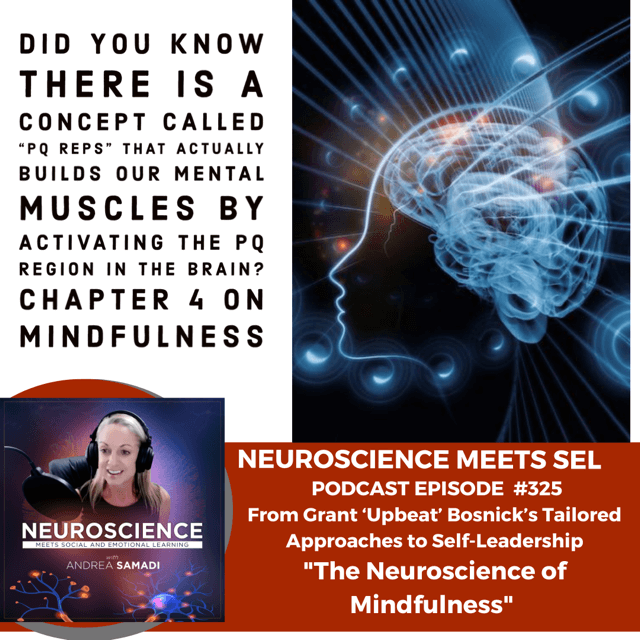
I loved this episode because I learned something new, and made a deeper connection to our past episodes.
I learned:
That there is a concept called PQ Reps, coined by Positive Intelligence Founder, Shirzad Chamine who used fMRI scanners to discover that by doing these PQ Reps we can actually build our mental muscles by activating this PQ Region in the Brain. For those who have a mindfulness practice in place, putting PQ Reps into practice helps to reaffirm the benefits that come along with building your mental muscles, and for those who have found it difficult to begin a mindfulness practice, PQ Reps is a proven way to bridge the gap for you to begin.
HOW DO WE PRACTICE THESE IMPORTANT PQ REPS? By rubbing our finger and thumb together, and involving any of our 5 senses for 10 seconds. I suggest that we feel the touch of our fingers on each other. By doing this, we are shifting our attention to our body and focusing on the sensation. It is this activity, that build up the PQ Area of our brain, while the survival part goes quieter.
If you next listen to Dan Siegel’s Wheel of Awareness Meditation[xiv] you will see how Dr. Siegel’s Mindfulness Practice is essentially teaching you to do PQ Reps involving every part of your body and feeling the sensations from your head to toe. Start small, practicing PQ Reps one day at a time, and eventually you will learn to focus your attention for longer periods of time, building your mental muscles and resilience in the process.
REVISIT THIS EPISODE TO REVIEW THIS CONCEPT IN DEPTH
EP 326 Chapter 5[xv] “The Neuroscience of Flow”
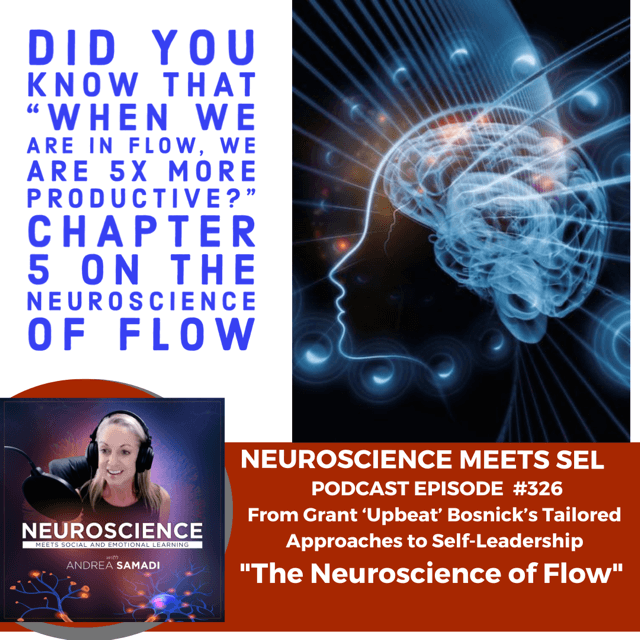
I learned that “when we are in flow, we are 5X more productive” and of course, who doesn’t want to be 5X more productive? We covered this topic back on EP 27[xvi] with Friederike Fabritius who first taught me the recipe for peak performance.
What I remember loving the most about Friederike’s first talk that I found back in 2017 that she did for high level executives in Barcelona, Spain, was that she accurately described what the psychologist, researcher and “father of flow” (known in his work environment as Mike C) that he devoted his entire lifetime to. And that is, what constitutes a happy life. “Mike C,” Mihaly Csikszentmihalyi, (from Claremont Graduate University in CA) along with Professor Martin Seligman of the University of Pennsylvania (who we’ve mentioned before on this podcast “set out to develop a focus on happiness, well-being, and positivity with a goal to create a field focused on human well-being and the conditions that enable people to flourish and live satisfying lives.”[xvii]
Friederike explained this concept of “flow” or “peak performance” as an optimal state that occurs when our brain releases three chemicals: noradrenaline (released with a challenge), dopamine (released with anything that gives you pleasure), and acetylcholine (released when you have focused attention).
She reminded us about learning to find our “optimal level” of performance by knowing thyself. Some people she says, need challenge to perform optimally (I’m like this for sure), and other people, you must take the challenge or pressure away for them to perform at their best. One person performs better with an element of “threat” that they perceive as a “reward” and this motivates them, while another person shuts down with this “threat.” To reach peak performance levels with YOUR work, it helps to know how you reach your optimal levels best.
In Chapter 5, Grant gives us tips for getting into this flow state.
- PICK A GOAL: Think of whatever it is you are working on a decide on the goal. Finish the presentation, or write the proposal or for me, finish writing this episode so I can record, edit and release it today.
- PRIME YOUR BRAIN FOR FLOW: Next he suggests bringing in mindfulness, that takes us back to our last episode where we learned about PQ reps. Use mindfulness to filter out your distractions and maintain control with your attention. I found it does help to let others around you know you’ve blocked off a time where you cannot be interrupted.
- THINK ABOUT THE BENEFIT OF THE GOAL: Why do you want to complete the thing you are working on. For me, with each podcast episode I write, record and release, it helps me to not only implement these new ideas into my own life, but I know I’m gaining skills that help me far beyond the content. Hosting this podcast, writing and recording these episodes, helps me to improve my presentation skills, communication, which improves my overall levels of confidence, let along what I’m gaining from implementing these ideas myself. I also hear from listeners like Tor Carberry from LinkedIn, who let me know he was looking forward to this episode. I don’t want to let others down, so this also motivates me to do my best work.
What about you? What benefits do YOU receive from whatever it is that YOU are working on?
- PUT YOURSELF ON THE EDGE: Ask yourself, is this challenging me? If it’s not, it might not get you into the flow state. If it is, then keep working, and see how far you can get. How long can you stretch your flow state.
I’ve stretched my flow state this morning from the minute I sat down at my desk. There’s always lots of distractions, but with practice, it becomes easier to block them out, and keep moving forward, with your end goal in mind. There’s nothing like the feeling of knowing you gave something your full attention, and effort.
REVISIT THIS EPISODE TO REVIEW THIS CONCEPT IN DEPTH
REVIEW and CONCLUSION:
To review and conclude this week’s episode #355 on PART 1 of our review of Grant Bosnick’s Tailored Approaches to Self-Leadership, we covered a review of the strategies that can help us to implement each concept, from chapter 2, 3, 4 and 5.
✔ EP 323 Chapter 2[xviii] “Using Neuroscience to Level Up Your Goals”
✔ EP 324 Chapter 3[xix] “The Neuroscience of Inspiration”
✔ EP 325 Chapter 4[xx] “The Neuroscience of Mindfulness”
✔ EP 326 Chapter 5[xxi] “The Neuroscience of Flow”
While listening to each episode can be a helpful review, so can revisiting your leadership self-assessment to see what might have changed for you this year. I did notice the leadership self-assessment link was not working for me to retake it this year, so I have reached out to Grant Bosnick and will update it as soon as he shares it with me. LINK IS HERE
In the meantime, I hope this review of the first 5 chapters of his book have helped you to think of NEW ways of thinking that will drive you towards whatever it is that you are working on this year.
With that thought, I do want to thank you for tuning in, and we will see you next time, with a review of the next 5 chapters.
See you next time.
ADDITIONAL RESOURCES
FOLLOW ANDREA SAMADI:
YouTube Channel: https://www.youtube.com/c/AndreaSamadi
Website https://www.achieveit360.com/
LinkedIn: https://www.linkedin.com/in/samadi/
Facebook: https://www.facebook.com/Achieveit360com
Neuroscience Meets SEL Facebook Group https://www.facebook.com/groups/2975814899101697
Twitter: https://twitter.com/andreasamadi
Instagram: https://www.instagram.com/andreasamadi/
REFERENCES:
[i] Neuroscience Meets Social and Emotional Learning Podcast EPISODE #134 with Kristen Holmes from Whoop.com https://andreasamadi.podbean.com/e/kristen-holmes-from-whoopcom-on-unlocking-a-better-you-measuring-sleep-recovery-and-strain/
[ii] Neuroscience Meets Social and Emotional Learning Podcast EPISODE #84 “ How a Spect Image Brain Scan Can Change your Life PART 3” https://andreasamadi.podbean.com/e/how-a-spect-scan-can-change-your-life-part-3-with-andrea-samadi/
[iii] https://andreasamadi.podbean.com/e/bonus-episode-a-deep-dive-into-the-top-5-health-staples-and-review-of-seasons-1-4/
[iv] Self-Assessment for Grant Bosnick’s book https://www.selfleadershipassessment.com/
[v] Neuroscience Meets Social and Emotional Learning Podcast EPISODE #321 with Grant ‘Upbeat’ Bosnick https://andreasamadi.podbean.com/e/insights-from-grant-upbeat-bosnick/
[vi] Neuroscience Meets Social and Emotional Learning Podcast EPISODE #323 on “The Neuroscience of Goals” https://andreasamadi.podbean.com/e/insights-from-season-11-of-the-neuroscience-meets-sel-podcast/
[vii] Neuroscience Meets Social and Emotional Learning Podcast EPISODE #324 “The Neuroscience of Inspiration” https://andreasamadi.podbean.com/e/a-self-leadership-series/
[viii]Neuroscience Meets Social and Emotional Learning Podcast EPISODE #325 “The Neuroscience of Flow” https://andreasamadi.podbean.com/e/the-neuroscience-of-peak-performance-and-happiness/
[x] Neuroscience Meets Social and Emotional Learning Podcast EPISODE #323 on “The Neuroscience of Goals” https://andreasamadi.podbean.com/e/insights-from-season-11-of-the-neuroscience-meets-sel-podcast/
[xi] Neuroscience Meets Social and Emotional Learning Podcast EPISODE #228 “HRV: The Most Important Biomarker for Tracking Health, Recovery and Resilience” https://andreasamadi.podbean.com/e/brain-fact-friday-review-of-heart-rate-variability-the-most-important-biomarker-for-tracking-health-recovery-and-resilience/
[xii] Neuroscience Meets Social and Emotional Learning Podcast EPISODE #324 “The Neuroscience of Inspiration” https://andreasamadi.podbean.com/e/a-self-leadership-series/
[xiii] Neuroscience Meets Social and Emotional Learning Podcast EPISODE #325 “The Neuroscience of Mindfulness” https://andreasamadi.podbean.com/e/insight-from-grant-bosnicks-tailored-approaches-to-self-leadership/
[xiv] Neuroscience Meets Social and Emotional Learning Podcast EPISODE #60 “The Science Behind a Meditation Practice with a Deep Dive into Dr. Dan Siegel’s Wheel of Awareness” https://andreasamadi.podbean.com/e/the-science-behind-a-meditation-practice-with-a-deep-dive-into-dr-dan-siegel-s-wheel-of-awareness/
[xv]Neuroscience Meets Social and Emotional Learning Podcast EPISODE #326 “The Neuroscience of Flow” https://andreasamadi.podbean.com/e/the-neuroscience-of-peak-performance-and-happiness/
[xvi] Neuroscience Meets Social and Emotional Learning Podcast EPISODE #27 with Friederike Fabritius on “The Recipe for Peak Performance” https://andreasamadi.podbean.com/e/pioneer-in-the-field-of-neuroleadership-friederike-fabritius-on-the-recipe-for-achieving-peak-performance/
[xvii] https://www.cgu.edu/people/mihaly-csikszentmihalyi/
[xviii] Neuroscience Meets Social and Emotional Learning Podcast EPISODE #323 on “The Neuroscience of Goals” https://andreasamadi.podbean.com/e/insights-from-season-11-of-the-neuroscience-meets-sel-podcast/
[xix] Neuroscience Meets Social and Emotional Learning Podcast EPISODE #324 “The Neuroscience of Inspiration” https://andreasamadi.podbean.com/e/a-self-leadership-series/
[xx]Neuroscience Meets Social and Emotional Learning Podcast EPISODE #325 “The Neuroscience of Flow” https://andreasamadi.podbean.com/e/the-neuroscience-of-peak-performance-and-happiness/
No comments yet. Be the first to say something!